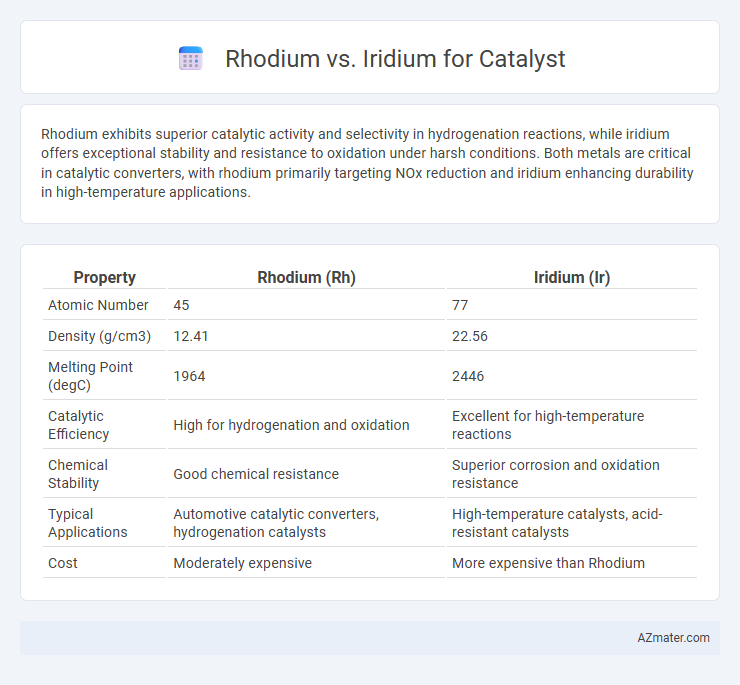Rhodium exhibits superior catalytic activity and selectivity in hydrogenation reactions, while iridium offers exceptional stability and resistance to oxidation under harsh conditions. Both metals are critical in catalytic converters, with rhodium primarily targeting NOx reduction and iridium enhancing durability in high-temperature applications.
Table of Comparison
| Property | Rhodium (Rh) | Iridium (Ir) |
|---|---|---|
| Atomic Number | 45 | 77 |
| Density (g/cm3) | 12.41 | 22.56 |
| Melting Point (degC) | 1964 | 2446 |
| Catalytic Efficiency | High for hydrogenation and oxidation | Excellent for high-temperature reactions |
| Chemical Stability | Good chemical resistance | Superior corrosion and oxidation resistance |
| Typical Applications | Automotive catalytic converters, hydrogenation catalysts | High-temperature catalysts, acid-resistant catalysts |
| Cost | Moderately expensive | More expensive than Rhodium |
Introduction to Rhodium and Iridium as Catalysts
Rhodium and iridium are precious metals from the platinum group, widely utilized as catalysts in industrial chemical reactions due to their exceptional catalytic properties. Rhodium exhibits high activity in hydrogenation and carbon-carbon bond formation reactions, making it crucial in automotive catalytic converters and fine chemical synthesis. Iridium's robustness and resistance to corrosion enhance its effectiveness in harsh reaction environments, including water splitting and hydrocarbon reforming processes.
Chemical Properties: Rhodium vs Iridium
Rhodium exhibits exceptional catalytic activity due to its ability to adsorb and activate hydrogen molecules, making it highly efficient for hydrogenation and hydroformylation reactions. Iridium is notable for its strong resistance to oxidation and corrosion, supporting its use in high-temperature catalytic processes and water-splitting reactions. Both metals belong to the platinum group, but rhodium's higher electron density enhances its catalytic selectivity, whereas iridium's robust chemical stability enables prolonged catalyst lifespan under harsh reaction conditions.
Availability and Sourcing of Rhodium and Iridium
Rhodium and iridium are both rare platinum group metals with limited global availability, primarily sourced from South Africa, Russia, and Canada. Rhodium is scarcer and more volatile in price due to its concentrated supply and high demand in catalytic converters, making its sourcing more challenging and costly. Iridium, while also rare, has a slightly more stable supply chain, often obtained as a byproduct of platinum and nickel mining, which affects its availability in industrial catalyst applications.
Catalytic Performance Comparison
Rhodium exhibits superior catalytic activity in hydrogenation and hydroformylation reactions due to its higher selectivity and turnover frequency compared to iridium. Iridium demonstrates enhanced stability and resistance to deactivation under harsh oxidative conditions, making it preferable for applications like water oxidation and C-H bond activation. Both metals offer distinct advantages, with rhodium favored for precision catalysis and iridium for durability in aggressive environments.
Common Industrial Applications
Rhodium and iridium are both critical catalysts in industrial applications due to their exceptional resistance to corrosion and high-temperature stability. Rhodium is predominantly used in automotive catalytic converters to reduce nitrogen oxides and carbon monoxide emissions, making it essential for environmental technologies. Iridium finds significant use in chemical synthesis, such as in the production of acetic acid via the Cativa process, due to its robust catalytic properties under harsh reaction conditions.
Cost and Economic Considerations
Rhodium and iridium are both critical catalysts in industrial applications, with rhodium typically commanding a higher price due to its greater rarity and stronger demand in automotive catalytic converters. The cost of rhodium can fluctuate significantly, often exceeding iridium by a substantial margin, which impacts the overall economic feasibility of its use in large-scale catalytic processes. Iridium, while generally less expensive, offers superior durability and corrosion resistance, potentially reducing replacement frequency and long-term costs despite its slightly lower market price.
Environmental Impact and Sustainability
Rhodium and Iridium catalysts both offer high corrosion resistance and efficiency in chemical reactions, but Rhodium is often preferred due to its superior ability to reduce nitrogen oxide emissions in automotive catalytic converters. Iridium catalysts demonstrate excellent durability and stability under extreme conditions, making them valuable for renewable energy applications such as water electrolysis for hydrogen production. Despite Iridium's scarcity and higher cost, its longer lifespan and potential for recycling contribute to greater sustainability compared to Rhodium's relatively higher environmental impact during mining and refining processes.
Stability and Longevity in Catalytic Processes
Rhodium exhibits exceptional catalytic stability and longevity due to its resistance to oxidation and poisoning, making it ideal for high-temperature automotive catalytic converters. Iridium, while highly stable in harsh chemical environments, often shows lower catalytic turnover frequencies but superior durability in acid media and fuel cell applications. Both metals maintain robust performance, yet rhodium's enhanced resistance to deactivation ensures prolonged catalyst life under oxidative conditions.
Recent Advances in Catalyst Research
Recent advances in catalyst research highlight Rhodium's superior efficiency in hydrogenation and carbon-carbon coupling reactions due to its unique electron configuration and surface properties. Iridium exhibits exceptional stability and resistance to sintering under harsh conditions, making it ideal for oxidation and water-splitting catalysis. Emerging studies emphasize bimetallic Rhodium-Iridium catalysts, which optimize activity and durability for industrial applications such as automotive exhaust treatment and green hydrogen production.
Choosing the Right Catalyst: Factors to Consider
When selecting between rhodium and iridium catalysts, consider factors such as catalytic activity, selectivity, and stability under reaction conditions. Rhodium often excels in hydrogenation and hydroformylation due to its high turnover frequency, while iridium is favored for oxidation reactions and C-H activation because of its robust resistance to deactivation. Evaluating substrate compatibility, reaction environment, and cost-effectiveness ensures optimal catalyst performance for specific industrial processes.

Infographic: Rhodium vs Iridium for Catalyst
 azmater.com
azmater.com